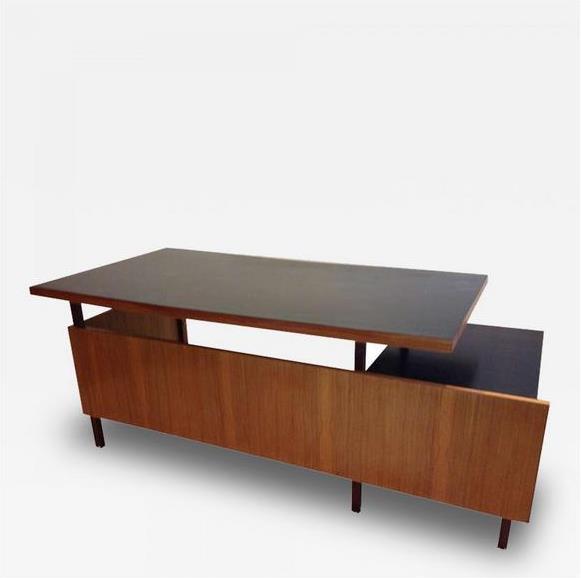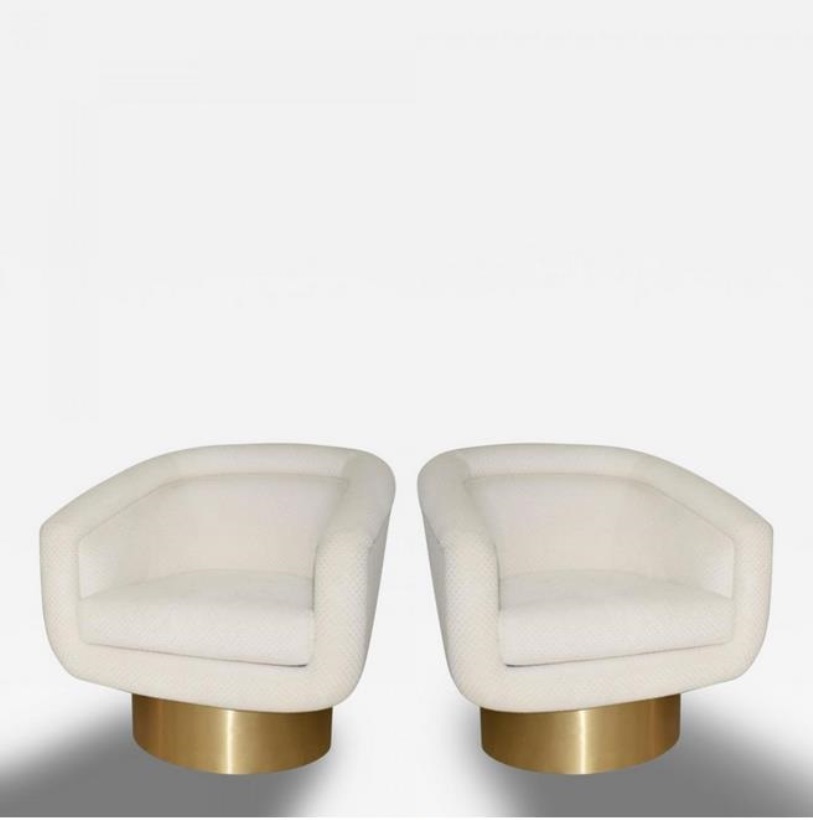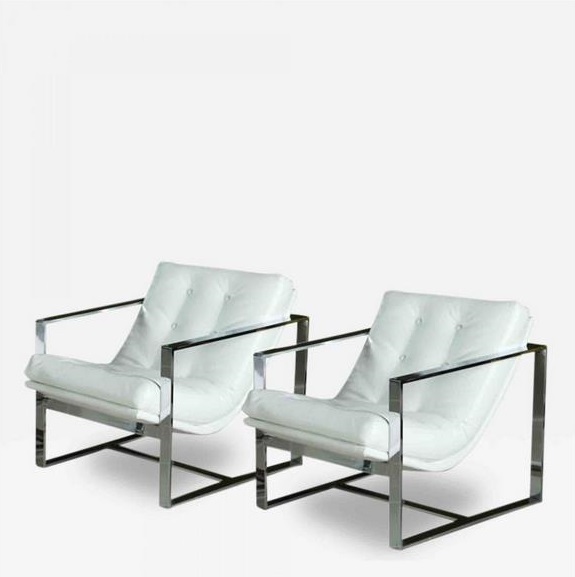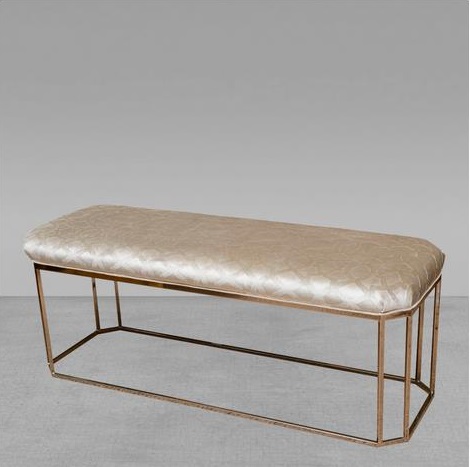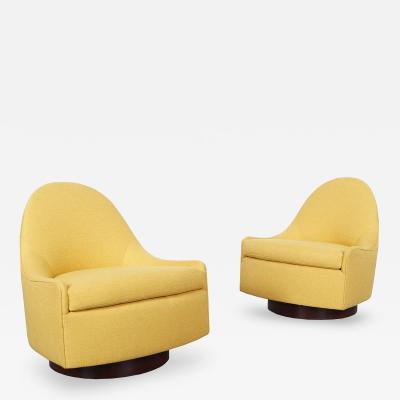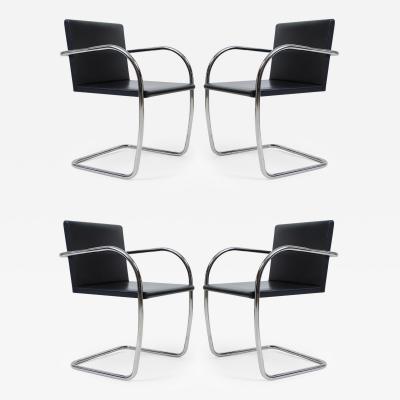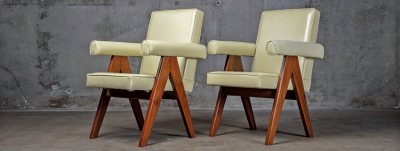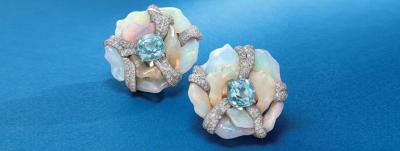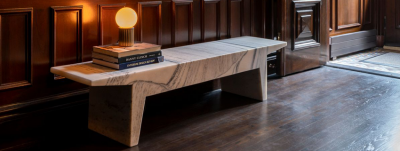Mid Century Modern Design Masters: Milo Baughman
Left to right: Milo Baughman desk. Offered by Glen Leroux Antiques; Early Milo Baughman scoop chairs, circa 1955. Offered by Fritz & Hollander.
There’s something, dare we say, sexy about Milo Baughman’s furniture. Sleek and sophisticated, his innovative designs manage to be both beautiful and comfortable, cutting-edge and classic. A firm believer that design should be, above all else, functional and accessible, Baughman relied on bold proportions, rich materials and restrained forms to create his distinctive and utterly timeless aesthetic.
Born in Kansas City in 1923, Baughman was raised in Long Beach, California, a laid-back coastal town that likely informed his ongoing quest for approachability in design. At thirteen, Baughman, a preternatural aesthete, was enlisted by his parents to develop an architectural plan for the family’s home. He completed designs for both the exterior and interior and his family went on to live in the house for the next thirty-four years.
Left to right: Large Milo Baughman rosewood cocktail table, circa 1970. Offered by Objects20c; Pair of Milo Baughman swivel chairs. Offered by Craig Van Den Brulle.
After graduating high school in 1941, Baughman spent four years in the Army Air Forces, where he occasionally designed officer’s clubs, before enrolling at the Chouinard Arts Institute (now the California Institute of the Arts) to study product and architectural design. Baughman landed a job creating window displays for Frank Brothers in Los Angeles, a pioneering modern furniture store responsible for furnishing Arts & Architecture magazine’s seminal Case Study Houses. With his foot firmly in the door, Baughman began creating his own custom designs and in 1947, at just 24 years old, he established Milo Baughman Design Inc.
Shortly after launching his firm, the commissions began to roll in. Baughman created designs for Glenn of California and Pacific Iron—both of which were at the forefront of the California Modern furniture movement—as well as Drexel in North Carolina and Winchendon Furniture in Massachusetts, which brought his crisp, cool west coast style to the east. In 1953, while in High Point, North Carolina, Baughman sealed the deal of a lifetime after a brief meeting with the furniture manufacturer Thayer Coggin.
Left to right: Six thin line Milo Baughman dining chairs in black mohair. Offered by Continuum 20th Century Design; A pair of Milo Baughman chrome and white leather cube chairs. Offered by Gary Rubinstein Antiques.
Coggin, who aimed to create stylish yet accessible furniture for post-war America, was floored by Baughman’s designs, which spoke directly to his vision. The two quickly embarked on a partnership that would last fifty years. Marrying Baughman’s creative vision with Coggin’s engineering and manufacturing prowess, the duo created an array of designs that came to define the modern American era. New York design dealer Craig van Brulle recalls, “I first discovered Milo Baughman’s work when I purchased a pair of Thayer Coggin sofas. I was drawn to their clean simple lines and I’ve been a fan ever since.”
Working with popular mid century materials such as leather, wood and metal, Baughman created furniture that was anything but ordinary. Florida-based antiques dealer Gary Rubinstein says, “I was first fascinated by his use of chrome and he really became the it guy for bringing chrome back as a major design element . . . at the time, most chrome was tubular in some way, but Baughman used it to create these flat surfaces, so his interpretation of chrome furniture was very cutting edge for that time and it really stood out as something different and unique . . . His use of woods in non-chrome pieces was also pretty extraordinary. He used figured birches and maples, book matched the veneers and created these really rich cabinet pieces. He took these woods that were [often associated] with antique furniture, and used them in a very modern, rectilinear way.”
Another Baughman hallmark is comfort. From his swivel and scoop chairs to his curvaceous lounges and ample sofas, each piece is as functional as it is stunning. To achieve this dichotomy, Baughman relied on simple silhouettes amplified by glamorous touches such as sumptuous velvet upholstery, chrome bases, and exotic wood elements. “Baughman’s furniture, especially his chairs and upholstered pieces, are extremely comfortable,” says Rubinstein. “They’re desirable because they are striking and really usable.”
Left to right: Milo Baughman sofa in mohair and mahogany. Offered by E.T. Burk; Milo Baughman chrome and upholstered bench, 1970s. Offered by Vermillion 20th Century Furnishings.
Thanks to this combination of simplicity and livability, Baughman’s mid century furniture remains decidedly timeless and versatile today. Rubinstein says, “Baughman’s work mixes very well with contemporary interiors as well as period interiors, and it works well with full mid century interiors. The geometry of the pieces find harmony with everything from Italian Neoclassical furniture to pier furniture of the 19th century.” This adaptability has made Baughman’s designs extremely popular among collectors. “In the last five years, I’ve seen a huge demand for his work,” says Rubinstein. Van den Brulle adds, “I feel the market for any designer’s work fluctuates, but Baughman’s uniquely American designs will always be in demand.”
Thayer Coggin continues to produce a number of iconic Baughman designs—a testament to their ageless quality—including his large circular sofa, the No. 951-103 chair, and his classic armless dining chairs, which have appeared in countless high-style dining rooms. Many of Baughman’s designs reside in the permanent collections of major museums, including the Museum of Modern Art in New York and the Los Angeles County Museum of Art.
To shop designs by Milo Baughman, click HERE.















